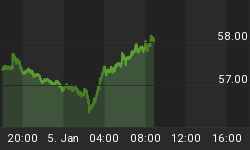This esay first appeared at Agora Financial's Gold & Options Trader.
Dear Gold & Options reader,
This just in. I hope you are sitting down.
The news that should be driving gold prices to the moon is out! The Federal Reserve released its latest weekly monetary data after the market closed Thursday.

The Federal Reserve has just expanded its balance sheet more in one month than it has in almost all of its first 86 years of existence. I am not kidding. Its assets, which represent the cumulative reserves the Fed has "created," totaled less than $700 billion at the turn of the millennium and continued to expand by about $50 billion per year after that, up until this month. In September alone, reserve bank credit inflated by almost $600 billion. It is a record, and has already affected the monetary base.

The relevant factors of increase in the month include:
-
$30 billion through the primary credit facility
-
$12 billion in securities purchases (T-bills)
-
$147 billion in credit extended to primary dealers, including MER, MS and GS
-
$152 billion through its new asset-backed commercial paper "Money Market Mutual Fund Liquidity Facility"
-
$220 billion in purchases of "other assets," probably related to the currency swaps
-
$60 billion to "other credit extensions," which include the AIG stuff
-
$140 billion in "securities lent to dealers" (which is an off-balance sheet item).
That adds up to roughly $621 billion (excluding the off-balance sheet item). Up until September, the Fed had been careful to sterilize its liquidity provisions by selling Treasuries, reverse repos or simply by lending its securities off balance sheet. So while it has extended credit since August 2007, it has not monetized much of the liquidity.
Besides, usually, other factors offset the Fed's injection of "liquidity," such as cash withdrawals from the banking system (represented by an increase in "currency in circulation") and other activities that may increase money flows back into the Fed... like the money raised by the Treasury for the Fed under its recently created "Supplementary Financing Program."
Since announcing this new program two weeks ago, the Fed has received about $350 billion from the Treasury. Additional factors of decrease include about $80 billion in deposits that came into the Fed during September via reverse repos and "other" deposits, a $26 billion decline in outstanding repos and about $4 billion in currency (cash) leaving the banking system. The NET factor of increase to reserve bank credit for the month of September was about $170 billion. That is money created out of thin air... unsterilized.

This number is unprecedented -- seriously -- in these here United States.
You can see this statistic in second chart at the top. Note the statistic "monthly changes in reserve balances with FR banks." This statistic measures the effects of Fed actions on reserves provided to the banking system. It is the net difference between factors supplying Fed funds and factors absorbing them. You can look at it like a measure of net money flows in and out of the Fed. It tells you whether the Fed is injecting unsterilized net liquidity, and how much.
Balance Sheet Shock
Note in the chart here how the composition of Federal Reserve assets has changed in just the last 12 months.
Historically, 75-80% of those assets consisted in Treasury securities.
That is because, traditionally, the Federal Reserve inflates by buying these securities in the open market, thereby increasing reserves in the banking system so that banks can create deposit money on top of that (and then Wall Street pyramids up too).
Now, you can see, the Fed has many windows open to it by which to inflate today. Indeed, in only eight months, the Fed's holdings of Treasuries have dropped to an unprecedented 31% of the Fed's assets. It gets worse.
As you can see in the graph below, the Federal Reserve has sold about $300 billion in Treasuries in order to fund its lending programs, leaving it with just under $500 billion worth.
However, since March, it has also swapped out about $270 billion of these securities through its off-balance sheet Term Securities Lending Facility (TSLF), leaving it only about $230 billion in wiggle room before it is forced to either collect (deflationary) or monetize the loans outstanding (inflationary).

That is, Treasury assets comprise just 16% of the Fed's balance sheet today, net of the TSLF.
That's astonishing. Indeed, it is probably why the Treasury is raising money, why it stopped selling its security holdings to sterilize its liquidity back in June and why the printing presses are on.
This news is very bullish for gold. It is one of the data points we were looking for to confirm our outlook. It is bullish for other commodities too. It may be bearish for the dollar, but only if other central banks hold back.
Not likely.
There's already talk of coordinated monetary policy actions and so on.
In the short term, the gold market is likely to key off the "bailout" and its impact on the stock market, which will hint to investors whether all is getting better. It likely will not, but it certainly is possible for Wall Street to bid up stock prices in response to this liquidity push too.
Consequently, it is difficult to predict gold's short-term response to this shock, but the market cannot ignore the fundamental effect of this crackup for long. This "liquidity" injection will ripple through the economy and dollar in the next few months and years in ways that not a single person can know.
The monthly money supply numbers probably do not come out for another week or so, but the early indications surely confirm what gold bugs could only surmise when they drove gold prices up to $910.
With interventions like this, we should get a few more $100-up days soon enough.
Good trading,















